
|
|||
|---|---|---|---|
|
|
Patterns of play in football and their associated physical and physiological demands Patrones de juego en el fútbol y sus exigencias físicas y fisiológicas asociadas |
|
|
|
*Graduated in Sports Science. Graduated in Physical Education Catholic University of Valencia. UCV. II Level Trainer of Football High Performance in Football. University of Granada **Graduated in Sports Science. University Pablo de Olavide, Seville High Performance in Football. University of Granada II Level Trainer of Football |
Rafael Ballester Lengua* Víctor López García** (Spain) |
|
|
|
Abstract Players may not need to have an extraordinary capacity within any of the areas of physical performance but must possess a reasonably high level within all areas. This explains why there are marked individual differences in anthropometric and physiological characteristics among top players. Various articles tend to evaluate specific aspects of football and the requirements of competition, we have worked with the most relevant ones since 1975- 2012. Keywords: Football. Physical demands. Physiological demands. Patterns of play.
|
|||
|
|
EFDeportes.com, Revista Digital. Buenos Aires, Año 17, Nº 175, Diciembre de 2012. http://www.efdeportes.com/ |
|
|
1 / 1
The most relevant authors in this review are the following
Jens Bangsbo
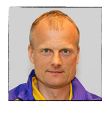 |
Jens Bangsbo is a Professor at the University of Copenhagen. He has many scientific publications, and is well know for his role in developing the Yo-Yo series of fitness tests. He is also one of the world's foremost experts in soccer training. In the field of soccer, he is an accomplished coach, instructor, author and player. He had a stint as the assistant coach for Juventus FC, where he helped contribute to technical, tactical and fitness training for the team. And recently he consulted for AEK Athens, where he supervised tactical aspects and individual development for the highly successful club. |
Peter Krustrup
 |
Professor Peter Krustrup has been appointed as Professor in Sport and Health Sciences at SHS in August 2011. Peter is a world leading expert in muscle physiology as well as performance, testing and training of elite team sport athletes. Peter is also recognized for his pioneering work on the fitness and health effects of recreational football, which has resulted in 25 scientific articles from 2009-2011 and world-wide media attention. |
Thomas Reilly
 |
Thomas Reilly is Professor of Sports Science and Director of the Research Institute for Sport and Exercise Sciences at Liverpool John Moores University. He is also the Director of the University's Graduate School. He holds a B.A. degree from University College, Dublin, a postgraduate Diploma from St Mary's College (Strawberry Hill), and MSc. from the Royal Free Hospital School of Medicine (London, 1971), PhD. from the Council for National Academic Awards, (1975) and DSc. from Liverpool John Moores University, (1998). |
The DSc. was awarded for his research work on circadian rhythms and exercise. He was awarded Doctor Honoris Causa from Vrije Universiteit Brussel in November 2001. He was sports science consultant with the British Olympic Association at the 1996 and 2000 Olympic Games. He is President Elect of the International Society for Advancement of Kinanthropometry. He is also President of the World Commission of Science and Sports and was a founder member of the European College of Sport Science. He chairs the International Steering Group on Science and Football which is affiliated to the World Commission of Science and Sports.
His professional awards have included Fellowship of the Institute of Biology; he is a fellow of the Ergonomics Society. He has authored or edited 24 books, including co-authorship of 'Science and Soccer' published by E. and F. N. Spon in 1996.
Professor Reilly received his research methods training whilst employed as a research technician at the National Institute for Medical Research in London in 1971-72. Subsequently he was Visiting Professor at the University of Tsukuba (Japan) in 1977 and Visiting Research Associate at the University of California (Berkeley) in 1980. He is currently Visiting Professor at the Technical University Lisbon.
Introduction
Patterns of play are the different actions which determine the football game itself. Thus, if we try to get to know the physical and physiological demands of football it is necessary to study and quantify the patterns of play as well. To achieve this purpose we have reviewed the most important studies about the most performed actions in a football game.
Walking or running
The following are guiding percentages defended by some autors; top players cover some 25% of their 8- 12 km distance by walking, 37% by jogging, 20% by submaximal cruising, 11% by sprinting and 7% by moving backwards (Reilly,1990, in press), mostly when they are not in possession of the ball.
In a recent study Bradley, P. S. & Krustrup, P., 2009 examine, using Pro Zone, the activity profiles of a large sample of English FA Premier League soccer players. The results were the following:
During matches, players stood for 5.6% (s=2.4) of the total time. Low-intensity activity represented 85.4% of total time, which consisted of 59.3% (s=4.8) walking and 26.1% (s=3.8) jogging. High-intensity runs represented 9.0% of total time, which consisted of 6.4% (s=1.6) running, 2.0% (s=0.6) high-speed running, and 0.6% (s= 0.2) sprinting. Players spent longer standing and walking in the second than the first half (standing: 181 s, s = 81 vs. 148 s, s=70, < P <0.01; walking: 1739 s, s=43 vs. 1674 s, s=150, P<0.01).
More time was spent jogging and running in the first than the second half (jogging: 769 s, s=109 vs. 723 s, s=126, P<0.01; running: 192 s, s=51 vs. 179 s, s=56, P <0.01). There was no difference in time spent in high-speed running or sprinting between the two halves Players performed more bouts of high-intensity running in the first than the second half (279,s=66 vs. 267, s=67, P<0.01). No differences were observed for sprint frequency between the two halves.
The results are in the same line that previous ones reported by other authors. Up to 90% of the activity is aerobic, but with some 7 min of higher-intensity activity (Bangsbo et al., 2009). In top competition, players must run with the ball once every 30 s on average, and make a 2-3s all-out sprint about once every 90 s; pauses for rest usually last no more than 2-3 s (Reilly, 1990, in press; Bangsbo et al., 2009). The maximal running speed reaches about 9 m/s; values are somewhat higher in attackers and defenders than goalkeepers and midfield players the average speed over an entire match is about 7.2 km/h.
Although playing positions are now relatively flexible, midfield players cover the greatest distance, mainly at moderate speeds. They, thus require anaerobic profile, with an ability to sustain effort at close to their `anaerobic threshold’ (Bangsbo 1994a,b). Centre backs engage in a higher proportion of sprinting, and they require stronger development of their anaerobic profile. It seems unlikely but the goalkeeper may cover a distance around 4 km during a game (Reilly, 1990 in press)
Heading movements
In practice, the main source of any head damage in adult players is physical contact with another participant. Nevertheless, damage from repeated improper heading of the ball remains a possibility, particularly in children and inexperienced players. The ball should be received in the middle of the forehead, where the skull is thickest, and the nature of the surface gives a greater margin for error.
It is important to train this ability altogether with the jump and having in mind to prepare the exercises the bearing with the opponent.
Throwing-in
Throwing-in also depends mainly on explosive movements, with the player attempting to exploit force developed in regions other than the arms. The handspring throw-in was developed to increase release speeds, but has now been largely abandoned.
Nowadays, is a pattern of play highly trained in some teams, especially in the Premier League. Some teams can equal a throwing-in action to a corner-kick, with a specific strategy developed for this action.
Receiving and kicking movements
Receiving and kicking the ball is continuously add to the basic metabolic demands of walking and running. Receiving requires relaxation of the body parts and is in relationship with the surface of the impact with the ball.
When kicking, rotational movements impart a high angular velocity to the foot. The release speed of the ball from an instep kick is in the range 17-28 m/s (Isokawa and Lees,1988), the values depending both on the skill of the player and the radius of rotational movement for the limb parts.
The maximal ball speed is strongly correlated with the peak isokinetic torque that a player can develop in the hip flexor and knee extensor muscles (Isokawa and Lees,1988). During pass kicking, the player orients the pelvis, the right leg and the foot towards the right, and introduces a medial component of foot velocity, but most of the speed of the foot is still developed by the knee extensor muscles (Levanon and Dapena, 1998). During such a kick, the ankle joint of the pivot leg becomes more firmly stabilized as skill increases, with both the knee and the hip joints contributing to maintenance of balance.
Sprinting
Recently, sprinting has been divided into two different types, leading and explosive sprints, as studied during English Premier League matches (Di Salvo et al., 2009). An explosive sprint (characterized by a fast acceleration) was defined as the attainment of sprint speed from standing, walking, jogging or running without entering the high-speed run category during the previous 0.5 s. A leading sprint (characterized by a gradual acceleration) was defined as the attainment of sprint speed from standing, walking, jogging or running while entering the high-speed run category during the previous 0.5 s time period.
Researchers have focused their attention on high-intensity activities during matches in the different national leagues, in particular the English Premier League (Bradley et al., 2009; Di Salvo et al., 2009), the Spanish League (Di Salvo et al., 2007), the Italian League and Danish League (Mohr et al., 2003). Some research on national leagues has included Champions League matches in the same data analysis (Di Salvo et al., 2007; Mohr et al., 2003; Rampinini et al., 2007). Recently Di Salvo et al, 2010 develop a detailed analysis of sprinting activities of elite soccer players during European Champions League and UEFA Cup games, paying particular attention to the type of sprint activities between different playing positions:
Positional differences
They established five playing position: central defenders, wide defenders, central midfielders, wide midfielders, and attackers. In addition, the sprints were classified by distance category: 0–5 m, 5.1–10.0 m, 10.1–15.0 m, 15.1–20.0 m, and > 20 m.
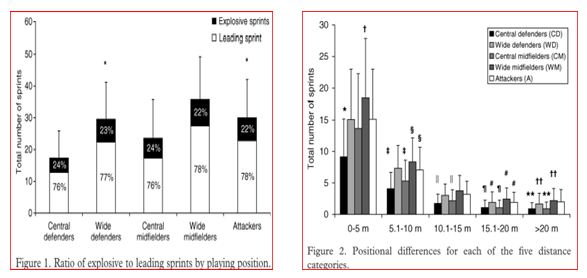
Source: Di Salvo et al 2010
It is evident that greater sprinting demands are made on wide midfielders and attackers (Di Salvo et al., 2009). The present study (Di Salvo et al., 2010) shows similar trends with wide defenders also performing elevated sprinting activities. In our view this could be related to the tactical roles of wide defenders who are often required to perform sprints in both defensive and attacking phases of play.
Among English Premier League players, Di Salvo et al. (2009) observed that central positions (central defenders and central midfielders) performed a higher percentage of explosive sprints, but this tendency was not observed in the present study.
These differences could be related to the types of competitions (Di Salvo et al.,2010) studied and the playing style predominant in a specific League. During the Champions League and the UEFA Cup, the different rules (i.e. away goals count double in the case of a tie, etc.) could affect the tactics used and therefore the physical demands of play
The results of the present are in line with previous research made by the same author (Di Salvo et al., 2009) showing that elite soccer players perform more sprints over short distances (0–10 m) than over longer distances (>10 m).
In our opinion, these physical differences generate the need to device specific training programmes for each playing position and pay special attention to exercises that have been used for a long time, as sprints of more than 30 m which are demonstrated by these investigations that are not very frequent in actual football.
In a recent study Bradley, P. S. & Krustrup, P., 2009 examine, using Pro Zone, the activity profiles of a large sample of English FA Premier League soccer players. The main results concerning playing positions were the following:
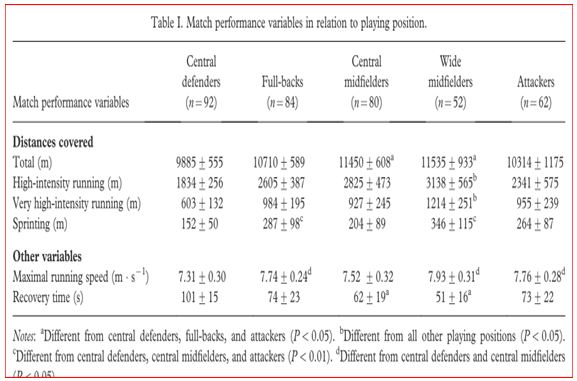
Source: Bradley, P. S. & Krustrup, P. 2009
The results show that high-intensity running and total distance covered were higher for wide (3138 and 11,535 m) and central midfielders (2825 and 11,450 m) than for full-backs (2605 and 10,710 m), attackers (2341 and 10,314 m), and central defenders (1834 and 9885 m).
Furthermore, it was observed that wide midfielders, full-backs, and attackers cover a greater distance when sprinting (346, 287, and 264 m, respectively) than central midfielders (204 m) and central defenders (152 m).
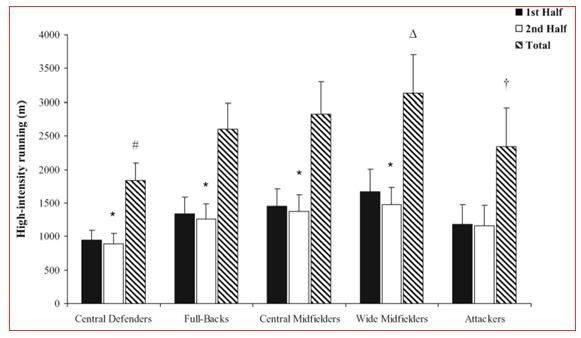
Source: Bradley, P. S. & Krustrup, P., 2009
An interesting ending of the this study is that the maximal running speeds reached during games were 6–8% higher for wide midfielders and attackers than for central defenders. Although the reliability of maximal running speeds were not determined in the present study, it is reasonable to conclude that large differences in maximal running speeds are present between playing positions. For wide midfielders, the maximal running speed may be related to the fact that their high-intensity runs are the longest, giving them more time to reach full acceleration. However, it is also likely that the attackers and wide midfielders have the highest running speeds, as shown by 30- and 40-m sprint tests (Bangsbo, Mohr, & Krustrup, 2006).
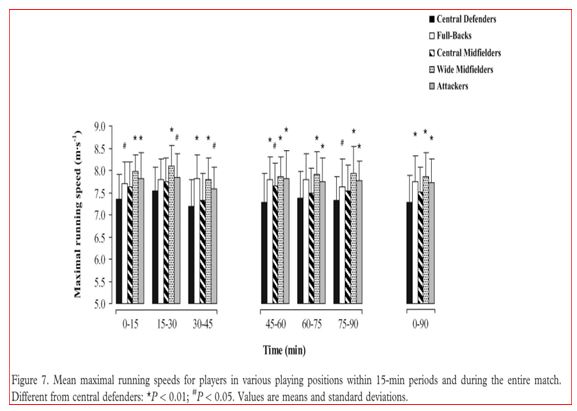
Source: Bradley, P. S. & Krustrup, P., 2009
Comparisons through years and between leagues
These data show that the total distances covered in the modern elite-standard English League are much higher than 30 years ago (Reilly & Thomas, 1976), but also reveal that the amount of high-intensity running is similar to the Italian Serie A and the Spanish Primera Division (Di Salvo et al., 2007; Mohr et al., 2003). The category for high-intensity running used in the present study (>14.4 km/h).
Similar values for high-intensity running were obtained for elite-standard English and Spanish League for all positions apart from attackers who performed less high-intensity running than their Spanish counterparts (2341 vs. 2708 m).
Furthermore, the present data suggest that the amount of high-intensity running is 10 –15% higher in the English FA Premier League than in the Danish (Mohr et al., 2003) and Swedish Premier Leagues (Andersson et al., 2007). To our mind this fact is related to the level of the league analyzed as well as the playing style predominant in each league.
In the English Premier League, Spanish League and the most competitive ones, players are required to maintain a high level of activity when they are not directly involved in play to create space, to receive passes or to pressure opponents into making mistakes in order to regain possession. For all these reasons the amount of high-intensity running is greater than in other leagues.
A very recent study reported by Spencer, M., Pyne, D., Santisteban, J., Mugica, I. (2011) investigate the relationship between repeated sprint ability and tests of 15-m sprint, 15-m agility, countermovement jump, and aerobic power; to determine how these relationships differed through the age groups in highly trained boys and adolescent association football players (age groups U11 to U18).
The results show that repeated-sprint ability is, in general, highly correlated with other aspects of physical performance, but some variability in these relationships between age groups in the adolescent years may be evidence of minor disruption in motor coordination abilities. The major finding of this study was that the correlations of repeated-sprint ability with agility (r =.02 to.92) and leg power (r =.48 to.93) varied considerably between the individual age groups.
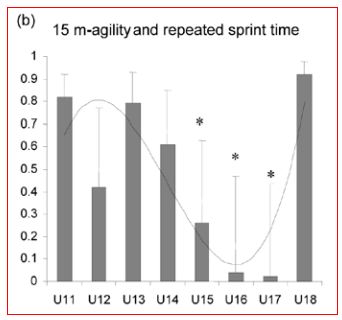
Source: Spencer, M., Pyne, D., Santisteban, J. Mugica, I. 2011
In contrast, the correlations of repeated-sprint ability with acceleration and aerobic conditioning were more consistent across the respective ages. Furthermore, the U18 age group displayed the highest correlations for repeated-sprint ability when compared with the acceleration, agility, and explosive leg power tests, suggesting that stabilization of overall physical performance is evident in this age group.
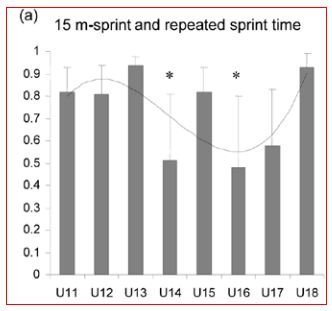
Source: Spencer, M., Pyne, D., Santisteban, J. Mugica, I. 2011
The moderate-to-very large correlations of repeat sprint total time with 15-m Sprint, in this study, are consistent with the findings of Mendez-Villanueva et al, 2011 who investigated the correlations of a very intense repeated-sprint test (10 × 30-m sprints) with acceleration (10-m sprint) and maximum running speed (flying 20-m sprint) in three groups of junior (U14, U16, and U18) football players. Furthermore, the present findings are in support of those of Pyne et al,2008 who reported a moderate correlation (r =.66) between a repeated-sprint test consisting of 6 × 30-m sprints and 20-m sprint time in highly trained junior male Australian Rules football players. Other studies have reported that repeated-sprint ability is closely related to anaerobic factors, such as muscle phosphocreatine breakdown(Spencer, M et al, 2006) and muscle buffer capacity.
To conclude, in our view coaches and athletes in the adolescent years should be educated on the possibility of short-term disruptions or impairment of physical performance during the midadolescent years. Coaches and physical trainers should be mindful of individual patterns of growth during this period and be able to adapt their training to them.
Strength and Strength Derivatives: Acceleration, Jump, Explosive Turning
A professional soccer player performs about 50 turns sustaining forceful contractions to maintain balance and control of the ball against defensive pressure during a game (Whiters, R., 1982)
Muscular power has traditionally been measured by means of vertical jumps, and reported values are between 500 and 600 mm for elite soccer players(Ekstrand J, et al, 1989)
One frequently participating in the European Champions League showed an average value of 164 ± 21.8kg one repetition maximum (1RM) in free weight half squats (down to 90 degrees between femur and tibia), whereas a team performing at a lower level, but still in the premier league, showed an average value of 135 ± 16.2kg. The corresponding jumping height measured using a Kistler force platform (Kistler AG, Switzerland) determining vertical movement of the centre of gravity was 567 ± 66mm and 531 ± 40mm for the two teams, respectively.
Maximal strength correlated highly to jump and sprint performance, showing a vertical jumping height of 564 ± 40mm in line with the findings of Reilly et al.,1990 and sprint times from a standing start of 1.82 ± 0.3 seconds, 3.0 ± 0.83 Acceleration, seconds and 4.0 ± 0.2 seconds for 10m, 20m and 30m, respectively. The corresponding r-values were r = 0.78 (p < 0.02) between 1RM and jumping height, r = 0.94 (p < 0.001) between 1RM and the 10m sprint, and r = 0.71 (p < 0.01) between 1RMand the 30m sprint
Typically, maximal strength is defined in terms of 1RM in a standardized movement, for example the squat exercise. Power is a product of force and the inverse of time, i.e. the ability to produce as much force as possible in the shortest possible time.
Research on strength training is often not conclusive in terms of sports training practice, often because of differences in measurement techniques. Traditionally, much research has been conducted using isometric measures or isokinetic movements. But for our view both of these have limited interest in terms of prediction value for dynamic sports.
The development of training methods has traditionally been based on specificity principles, and training is intended to correspond to specificity in the sport itself in terms of contraction type, contraction force, movements and velocity (Sale, D., 1992). Principally, two different mechanisms, muscular hypertrophy and neural adaptations, are the basis for the development of muscular strength.
Over the last decade, the focus of strength training has turned to neural adaptations. It has been suggested that the intent to make a high-speed contraction may be the most crucial factor in velocity specificity Findings from Almasbakk and Hoff point to the development of coordination as the determining factor in early velocity-specificity. (Behm, D. et al, 2004)
An increase in maximal strength is usually connected with an improvement in relative strength and, therefore, with improvement of power abilities. A significant relationship has been observed between 1RM and acceleration and movement velocity. By increasing the available force of muscular contraction in appropriate muscles or muscle groups, acceleration and speed in skills critical to soccer such as turning, sprinting and changing pace may improve.
Few training intervention studies have been conducted in soccer. Hoff and Helgerud (2002) showed that in soccer players training three times a week for 8 weeks training for neural adaptations (five repetitions in four sets using 85%+ of 1RM with emphasis on maximal mobilization in the concentric action) gave a half squat 1RM increase from 161 to 215kg in a group of 8 players. Their rate of force development was at the same time enhanced by 52%. Results of sprints over 10m improved by 0.08 seconds from 1.91 to 1.81, or almost 1m over 10m. performance over 40m improved by 0.13 seconds from 5.68 to 5.65 seconds. can vary considerably
Concurrent Strength and Endurance strength training in Soccer
Several authors have concluded that endurance training inhibits or interferes with strength development (Hennessy, L., et al 1995)
On contrast, one study has been carried out intervening in an elite soccer team with concurrent high-intensity for long-interval endurance training and maximal strength training for neural adaptation (Helgerud, J., et al, 2002) Twenty-one elite soccer players, having recently participated in the European Champions League, took part in the study. During an 8-week intervention, VO2max increased from 60.5 ± 4.8 to 65.7 ± 5.2 mL/kg • min, and the half squat 1RM increased from 115.7 ± 23.1 to 176.4 ± 18.2kg. Also, 10m sprints improved by 0.06 seconds, or more than 0.5m; vertical jumping height increased significantly by 3cm; and running economy improved by 4.7%. The overall conclusion was that there appear to be no negative effects of carrying out concurrent high-intensity aerobic training and maximal strength training. To increase performance level, both maximal strength and high-intensity long-interval training should be included in pre-season training for top soccer players.
Conclusion
To conclude, we would like to point out that we are convinced that we can use different training stimulus depending on our goals. The most important aspect for us, in the line of authors as Seirul·lo, F. or Fradua, L., is to design exercises which simulates the sport movements as closely as possible in terms of movement pattern, recreating if it is possible real situations of the game mixing at the same time physical, tactical and physiological aspects.
Bibliography
-
Andersson, H., Ekblom, B., and Krustrup, P. (2007). Elite football on artificial turf versus natural grass: Movement pattern, technical standard and player opinion. Journal of Sports Sciences, 8, 1 -10
-
Behm, D. G., Button, D. C., Barbour, G., Butt, J. C., & Young, W. B. (2004). Conflicting effects of fatigue and potentiation on voluntary force. Journal Of Strength & Conditioning Research (Allen Press Publishing Services Inc.), 18(2), 365-372.
-
Bangsbo, J. (1994a). Energy demands in competitive soccer. Journal of Sports Sciences, 12, 5-12.
-
Bangsbo, J.(1994b). Physiological demands in Football (Soccer) (edited by B. Ekblom), pp. 45-58. Oxford: Blackwell Scientific.
-
Bangsbo, J., Mohr, M., and Krustrup, P. (2006). Physical and metabolic demands of training and match-play in the elite football player. Journal of Sports Sciences, 24, 665–674.
-
Bansbo, J., Rampinini, E., Iaia, F.M. (2009). High-Intensity Training in football. International Journal of Sports Physiology and Performance. 4, 291-306.
-
Bradley, P. S., Sheldon, W., Wooster, B., Olsen, P., Boanas, P., and Krustrup, P. (2009). High-intensity running in English FA Premier League soccer matches. Journal of Sports Sciences, 27, 159–168.
-
Di Salvo, V., Baron, R., Tschan, H., Calderon Montero, F. J., Bachl, N., & Pigozzi, F. (2007). Performance characteristics according to playing position in elite soccer. International Journal of Sports Medicine, 28, 222–227.
-
Di Salvo, V., Gregson, W., Atkinson, G., Tordoff, P., & Drust, B.(2009). Analysis of high intensity activity in Premier League soccer. International Journal of Sports Medicine, 30, 205–212.
-
Di Salvo, V., Baron, R., González-Haro, C., Gormasz, C., Pigozzi, F., & Bachl, N. (2010). Sprinting analysis of elite soccer players during European Champions League and UEFA Cup matches. Journal Of Sports Sciences, 28(14), 1489-1494.
-
Ekstrand, J. J., & Gillquist, J. J. (1982). Frequency of muscle tightness and injuries in soccer players. American Journal Of Sports Medicine, 10(2), 75-78.
-
Hennessy, L. L. (1990). Plyometrics: important technical considerations. Athletics Coach, 24(4), 18-21.
-
Hoff, J. J., Wisloff, U. U., Engen, L. C., Kemi, O. J., & Helgerud, J. J. (2002). Soccer specific aerobic endurance training. / L'entrainement d'endurance aerobie specifique au football. British Journal Of Sports Medicine, 36(3), 218-221.
-
Isokawa, M. and Lees, A. (1988). A biomechanical analysis of the instep kick motion in soccer. In Science and Football (edited by T. Reilly, A. Lees, K. Davids and W.J. Murphy), pp. 449-455.London: E & FN Spon.
-
Levanon, J. and Dapena, J. (1998). Comparison of the kinematics of the full-instep and pass kicks in soccer. Medicine and Science in Sports and Exercise, 30, 917-927.
-
Mendez-Villanueva, A., Buchheit, M., Kuitunen, S., Douglas, A., Peltola, E. and Bourdon, P. (2001). Age-related differences in acceleration, maximum running speed, and repeated-sprint performance in young soccer players. Journal Sports Sciences, 9, 477–484.
-
Mohr, M., Krustrup P. and Bangsbo, J. (2003). Match performance of high-standard soccer players with special reference to development of fatigue. Journal Sports Sciences. 21, 519–528.
-
Rampinini, E., Coutts, A. J., Castagna, C., Sassi, R. and Impellizzeri, F. M. (2007). Variation in top level soccer match performance. International Journal of Sports Medicine, 28, 1018-1024.
-
Reilly, T., & Thomas, V. (1976). A motion analysis of work-rate in different positional roles in professional football match-play. Journal of Human Movement Studies, 2, 87–89.
-
Spencer, M., Pyne, D., Santisteban and, J., Mujika, I. (2011). Fitness determinants of Repeated-Sprint Ability in Highly Trained Youth Football Players International. Journal of Sports Physiology and Performance. 6, 497-508
Another articles in English
 |

Búsqueda personalizada
|
|---|---|
|
EFDeportes.com, Revista
Digital · Año 17 · N° 175 | Buenos Aires,
Diciembre de 2012 |
|